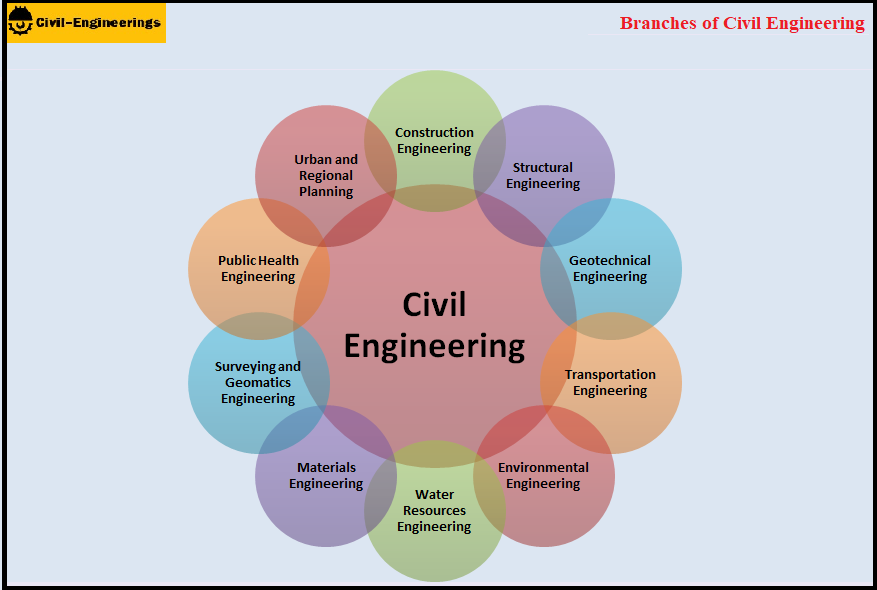Table of Contents
What is Civil Engineering?
Civil engineering is not only an engineering discipline; it is the way of developing the world. This is the most important and oldest field of engineering and historically civil engineering started when the first human developed a place for his living. Civil engineering is a very vast engineering discipline, starting from concept, planning and designing of any project to the execution and maintenance of the project. In today's world, civil engineering is a profession and a person who has a civil engineering degree is called a civil engineer.
Branches of Civil Engineering

In modern times civil engineering become biggest engineering discipline and has a huge scope of work therefore this filed is further categorize in different branches, such as Construction Engineering, Structural Engineering, Geotechnical Engineering, Transportation Engineering, Environmental Engineering, Water Resources Engineering, Materials Engineering, Surveying and Geomatics Engineering, Public Health Engineering, and Urban and Regional Planning etc.
1. Construction Engineering
Construction engineering is the main branch of civil engineering. This field covers the management and execution of all types of construction works. Construction Engineering focuses on the planning, management and execution of construction projects (i.e. buildings, infrastructure and facilities). Civil engineers oversee the entire construction process from design and budgeting to project management and safety measures to ensure that structures should built efficiently and meet quality standards.
2. Structural Engineering
Structural engineering ensures that the physical structures of projects such as buildings, bridges and dams can bear the load and stress they will face after construction. Structural engineering work starts after the preparation of architectural drawings. Structural engineers design the reinforcement and features of foundations, columns, beams and slabs etc., to ensure they can withstand various loads and forces such as weight, wind, earthquakes and temperature changes.
3. Geotechnical Engineering
Geotechnical engineering is the branch of civil engineering deals with earth materials (i.e soil, aggregates and rocks) and underground earth conditions to support safe foundation design for structures. Geotechnical engineers analyze the ground conditions, assess stability and design suitable foundations to support infrastructure safely and effectively.
4. Transportation Engineering
Safe and efficient movement of people and goods from one place to another place is covered in transportation engineering. In this field, transportation engineers design, plan and manage transportation systems, including roads, railways, airports and ports.
5. Environmental Engineering
Wastewater treatment, pollution control, waste management and sustainable building designs are covered in environmental engineering. This branch of civil engineering addresses environmental issues related to water, air and land to promote public health and sustainable development. Environmental engineers work on water and air quality, waste management, pollution control and sustainable practices to minimize the negative impact of human activities on ecosystems.
6. Water Resources Engineering
Planning, designing, construction and management of dams, canals, reservoirs, flood control and irrigation systems is covered under Water resources engineering. Water resources engineers design systems for water supply, flood control, irrigation and hydropower to ensure sustainable use and protection of water resources.
7. Materials Engineering
Materials engineering is the branch of civil engineering that deals with construction materials, such as concrete, steel, asphalt and composites to improve durability and performance of structures. This branch focuses on material research, testing and development. It helps to optimize materials for better performance and lower costs in construction projects.
8. Surveying and Geomatics Engineering
Using measurements and mapping to define land boundaries, construction layouts and geographic data for planning is covered in surveying and geomatics engineering. Surveyors and geomatics engineers use advanced technologies to create accurate maps and spatial data essential for planning and development.
9. Public Health Engineering
Public Health Engineering is the branch of civil engineering that deals with the design and management of infrastructure that promotes public health and improves community wellbeing. Public health engineers work on systems that prevent the spread of disease, ensure safe drinking water and manage waste effectively to protect human health and the environment. They design systems to promote safe water, sanitation and waste disposal in communities.
10. Urban & Regional Planning
After a huge migration of people from villages to cities, urban and regional planning becomes very important to manage this migration. This branch of civil engineering focuses on designing and organizing urban spaces, infrastructure and resources to optimize land use and ensure sustainable urban growth. Urban and regional planners focus on designing and managing the growth of cities and towns to create efficient, livable and sustainable communities. This branch involves zoning, transportation planning, land use and environmental management to enhance quality of life and economic development.
Role of Civil Engineering in World Progress
Without civil engineering, achieving the goals of a progressive world is impossible because every activity that is essential for global advancement and improving people's lives is linked with civil engineering. This engineering field plays a transformative role in global progress by designing and constructing the essential infrastructure that supports modern life. High rise building, Roads, bridges, water supply systems, sustainable energy plants, clean drinking water, sewerage systems and reliable energy sources, theses all are outcomes of civil engineering.
Sustainable Civil Engineering Practices
Sustainable civil engineering practices focus on minimizing the environmental impact of civil engineering's activities. Key sustainable practices in civil engineering include:
- Use of materials like recycled concrete, fly ash, bamboo and reclaimed steel to reduce the resource consumption and also decrease carbon emissions. Civil engineers also focus on innovations like green concrete and other low carbon alternatives to traditional materials.
- Sustainable designs emphasize reducing energy consumption in buildings and infrastructure by use of maximum natural day light and air. Passive solar design, improved insulation and energy efficient systems like LED lighting, green roofs and solar panels are contributing to lowering energy demands.
- Development of sustainable projects for reuse and management of rainwater, greywater and stormwater. Engineers design green infrastructure, like permeable pavements and bio retention areas to manage runoff and reduce flooding risks.
- Reducing construction waste and reusing materials help limit landfill use and resource depletion. Pre fabrication, modular construction and 3D printing enable more precise material use and minimize waste on construction site.
- Low Impact Development strategies aim to reduce environmental disruption by preserving natural landscapes, reducing impervious surfaces and managing stormwater close to its source. This approach helps restore and protect natural ecosystems.
- Civil Engineers consider the entire lifecycle of structures to maximize durability and minimize future maintenance. Sustainable projects are designed for adaptability and allowing them to be multipurpose usage.
- Utilizing sensors, IoT and data analytics enables efficient monitoring of resource usage and helps to optimize maintenance schedules, reducing energy, water and material waste over time.
These sustainable civil engineering practices collectively aim to build infrastructure that supports environmental health, economic viability and social wellbeing for future generations.






